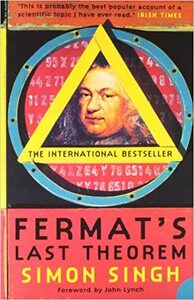You need to sign in or sign up before continuing.
Take a photo of a barcode or cover
The first time I read this book several years ago, it gave me my first real appreciation for mathematics. Numbers are not my forte and can be somewhat intimidating on occasions, but Simon Singh's style brings out the beauty and enthusiasm that numbers have generated in people through the millenia.
Reading it again now, I can appreciate the beauty and fascination of Maths and how numbers shape the universe. You don't need to be a maths genius to read it and the new look at the world around you that is gained is priceless.
Reading it again now, I can appreciate the beauty and fascination of Maths and how numbers shape the universe. You don't need to be a maths genius to read it and the new look at the world around you that is gained is priceless.
This is what I'd classify as a Boring-Facinating Read. I think I came across it on somebody else's BookCrossing Wish List & thought it was a fictional mystery (going by the title and cover) in the same vein as The Da Vinci Code, so added it to mine. Then some kind soul was generous enough to RABCK me a copy. So when I actually started reading it I was in for quite a surprise. For me the most facinating elements were the history of mathematics, and mini biographies of key mathematicians. I was blown away with their total and absolute dedication to figuring things out. I found it so hard to get my head around how they could spend years working out the very complicated ins and outs of completely mind boggling conundrums! To be honest the mathematical elements were not so interesting for me, they went over my head a bit (and I was actually very good at mathematics and sciences at school). Guess that's what happens when you let your brain rot away in a fairly unstimulating job for so long...
Fermat's Last Theorem begins with Pythagoras, goes through Fermat's positing of his theorem, the attempts by Euler and others to solve it, and culminates with Andrew Wiles's solution. It is generally entertaining and has the occasional equation, with a few more in the Appendix. But most of the relatively light analytical machinery in the book is devoted to ancillary problems or general illustrations, Singh does not even go beyond an extremely superficial description of the main feature of Fermat's proof in the case of n=4. Instead a lot of the space is filled with detours that are often found in these sorts of books, from the role of women in French mathematics in the 19th Century to the puzzle fad in the early 20th Century. In that way this book fell short of Singh's Big Bang which felt more focused and a little more thorough in trying to describe how scientists discovered what they did about the big bang.
Perhaps one of the best books I have read over the last year. It’s a non-fiction story that reads like fiction. The book does an excellent job presenting mathematical concepts in an accessible way that allows readers to appreciate the importance and beauty regardless of the reader’s prior mathematics knowledge all while plotting a riveting story from the 1600’s into the late twentieth century. Cannot recommend enough.
Brilliant book! The math is explained so well - not merely skipped over as "too hard" (as is the case with so many pop science books), but with enough detail to make sure the average layperson can follow.
challenging
informative
inspiring
medium-paced
I really enjoyed this (sorry dad for saying I wouldn't). For a book that introduced me to a lot of previously unknown mathematical concepts, it was suprisingly pacey. Definitely for nerds only but not necessarily just maths nerds
The history of attempts to solve Fermat's Last Theorem is interesting, but after reading this book I'm no closer to understanding the proof itself. Perhaps unsurprising given that Wiles' paper is longer than this entire book - but I wish the math described went beyond the surface level.
challenging
emotional
informative
inspiring
medium-paced
made me cry
informative
medium-paced
Informative yet a bit repetitive on some topics: oftentimes, the very same phrase is repeated multiple times across the chapters, making it slightly annoying… overall a nice reading, I would not consider it a deeply informative reading, given that the mathematical aspects presented are pretty elementary (sometimes even basic)
inspiring
medium-paced





